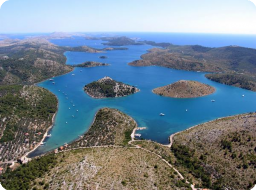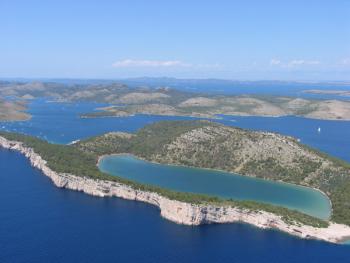

Telašćica Nature Park
Telašćica Nature Park  Lake Mir
Lake Mir
Lake Mir is located in the south-western part of the Telašćica Nature Park. The lake is situated in a narrow area of land between Telašćica Bay and the open sea. After the last Ice Age, the sea level rose approximately 120 metres and the karst depression was filled by the sea, which entered through numerous underground channels, which are particularly numerous on the northern side. Where the sea enters is easy to recognize during the tides. The size of the lake is approximately 900 metres by 300. Its maximum depth is 6 metres. The lake is saline because its underground channels are connected with the sea. The salinity of the lake is generally higher than the surrounding sea due to evaporation and the fact the lake is closed off. In Lake Mir, very small changes in the water level occur since the cracks which connect the lake with the sea have a low porosity. On the south-eastern side of the lake, the sea tends to spill over into the lake during storms. The shores of the lake are mostly low and rocky, with numerous depressions, while only in the extreme north-western part can an accumulation of sand be seen. The lake bottom in shallow areas is rocky and in deeper areas is covered with clay. Part of the south-east bed is covered with a fine grey silt (curative mud).

Differences in temperature can be very pronounced (in summer up to 33 ºC and in winter 5 ºC). Because of this, the lake is warmer than the surrounding sea in the summer and colder in winter due to its shallowness. The salinity of the lake is higher than average due to evaporation. These extreme conditions are the cause of the biological impoverishment of the lake. Apart from plankton, there are only a few species of marine organism. These include: algae, goby, mullet, sea bass, several species of shellfish, snails, crabs and a special type of eel (called kajman or bižat by the locals), which can grow up to 3 kg.
Source: www.telascica.hr
Video
Current news
 Macrocruise charter agency
Additional discount on the boat rental price of betw
Macrocruise charter agency
Additional discount on the boat rental price of betw




























